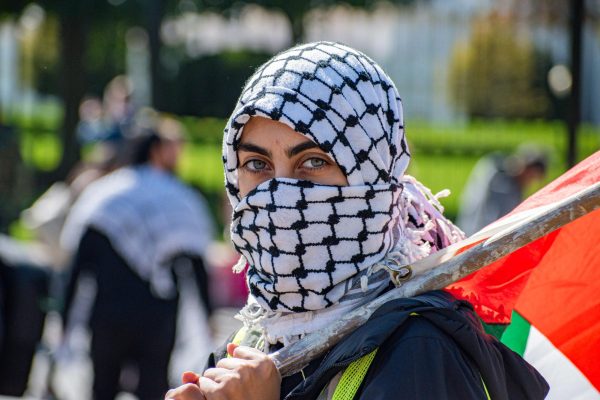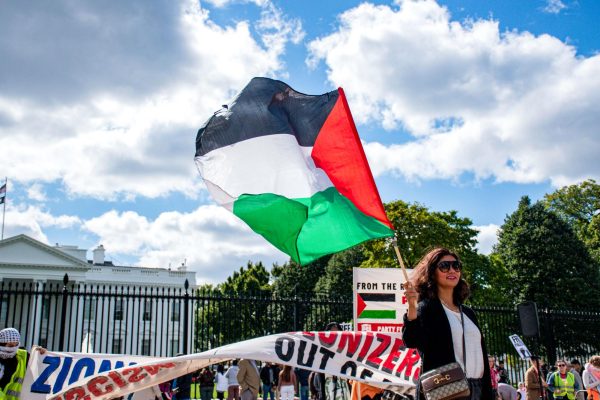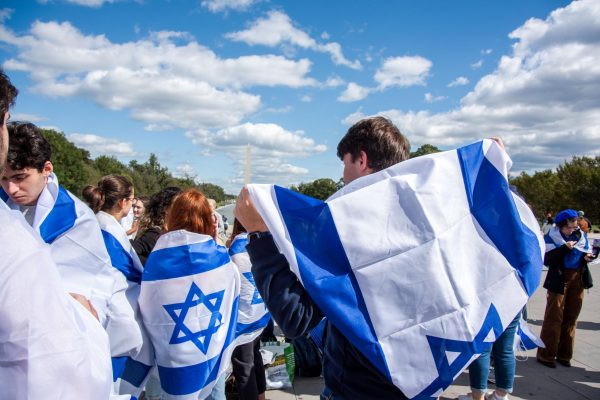On Sunday, Israel’s government declared war on Hamas, a Palestinian fundamentalist group that rules the Gaza Strip, after Hamas militants launched the most devastating attack on Israel in 50 years.
Hamas attacked Israel by land, air and sea in a surprise assault Saturday that included barrages of rockets, mass kidnappings and the destruction of a segment of the border wall separating Israel and Gaza. Israeli forces responded to the attacks with airstrikes and artillery in Gaza, cutting electricity off from the strip and calling for reserves to help reclaim Israeli towns.
Within 36 hours of the assault, at least 1,100 people have been killed — at least 700 in Israel and at least 493 in Gaza — with thousands more still missing.
Hamas’ offensive came on the tail end of a major Jewish holiday, Sukkot, a weeklong celebration commemorating the fall harvest, and right after the 50th anniversary of the Yom Kippur War, when Arab forces ambushed Israel in a coordinated strike on the Yom Kippur holiday.
The militant group’s escalation is a return to war following decades of tension between Palestine and Israel. Animosity among Palestinians has remained high amid Israel’s occupation of the West Bank, blockade of Gaza, repeated police raids of the third-holiest mosque in Jerusalem, and the nearly 5,200 Palestinians currently jailed on Israeli soil.
In response to the attacks on Israel and the following counterattacks on Gaza, demonstrators convened in rallies and protests in downtown D.C. on Sunday to stand with their respective communities and voice their feelings on the violence that continues to unfold.
The groups shared sentiments that likely encapsulate only a portion of the breadth of Israeli and Palestinian emotions about the attacks. But the demonstrations — and the students who led them — represent splintered factions as the federal government clambers to respond to the conflict.
In the first of two demonstrations Sunday, roughly 60 people convened in front of the White House at 1 p.m. for “All Out For Palestine,” an event hosted by the Palestinian Youth Movement.
Attendees at the first rally, including children and senior citizens, wrapped the Palestinian flag around their waist while others held signs reading “Palestine will be free” and “Resistance is Justified.” Many wore keffiyehs, a traditional Arab headdress, while chanting and delivering speeches.
The crowd soon swelled to about 200 demonstrators, with chants of “Free, free Palestine” echoing down Pennsylvania Avenue.

Speakers and attendees from local organizations like Students for Justice in Palestine and D.C. Alliance Against Racist and Political Oppression said Hamas’ offensive signals Israel’s weakening grasp on the territory that many of them consider home, igniting a beacon of hope for Palestinian resistance.
“Yesterday marks one of the most significant turning points in our history of Palestinians,” said one speaker from the Palestinian Youth Movement. “October 7th is the beginning of our victory, of our relentless liberation, of our return home.”
The United Nations divided the region into modern-day Israel, the West Bank and the Gaza Strip in 1947, cementing Israel as a Jewish state the year after. After the Holocaust, many Jewish people moved to create a Jewish state in the region, which has religious significance for the Jewish, Muslim and Christian faiths.
The 1947 formation of Israel displaced more than 750,000 Palestinians, who had called the region home for centuries, and sparked decades of territorial and religious disputes.
At roughly 2:30 p.m., demonstrators began to march down Pennsylvania Avenue before heading south on 17th Street and onto Constitution Avenue.
Within the hour, the throng pushed toward the State Department, chanting, “Netanyahu, you can’t hide, we charge you with genocide.” Protesters at the crest of the crowd held a banner reading “Zionism is Fascism” and “Colonizers out of D.C.”

When they reached the State Department, demonstrators unfurled a Palestinian flag that spanned the width of the street. Chants continued as the remaining attendees listened to closing remarks from speakers before concluding the rally with music and dancing.
A leader for GW Students for Justice in Palestine — who wished to remain anonymous out of fear of violent retaliation and doxxing — said protesters across the country who stand in solidarity with the resistance help channel the emotions of Palestinians fighting for freedom from Israeli control.
“Our people need an outlet for their anger, for their rage, for their joy, for their hope,” he said. “Part of these actions are how we organize our community around those emotions, so those emotions and that agitation gets mobilized toward something that pushes us closer to liberation.”
The leader said he feels hope and joy about the future of Palestinian people who he says are reclaiming their land. But after domestic and global leaders backed the first wave of an Israeli counteroffensive operation that is expected to escalate in scale, he fears further retaliation from Israel for the attacks.
Just more than a mile away on the steps of the Lincoln Memorial, more than 75 demonstrators, including students from GW, Georgetown and American universities, gathered solemnly for the day’s second rally.
Israeli flags draped over attendees’ shoulders as many circled the rally’s speakers, which included student leaders from GW for Israel, AU’s Students Supporting Israel and Georgetown Israel Alliance. Some adults spoke in hushed Hebrew as speakers recounted testimonies of losing loved ones to the Hamas attack.

Between sobs, Tamara Listenberg — an AU student from Tel Aviv and the co-president of AU’s Students Supporting Israel — said she found out Sunday morning that Hamas killed her friend and his father. She held up a photo of her friend for the crowd and spoke about his commitment to helping others through charity work, urging demonstrators to fight for Israel.
She said her two brothers, one of whom is an AU student, set off to fight to protect the lives of Israeli civilians after hearing news of the attacks.
“He didn’t have to. But that is what being Israeli is about,” Listenberg said in a speech. “We don’t run away. We come back home and we fight.”
Rally organizers passed out sheets with Hebrew prayers and photos of people who died or were taken hostage following Saturday’s attack. Demonstrators clasped the photos in front of their chests while some held banners reading “We stand with Israel, bring back our family.”
GW junior Sabrina Soffer — a Hatchet opinions writer, a speaker at the rally and the co-chair for education of GW for Israel — said she woke up to a stream of notifications Saturday morning from friends and family asking if she had heard about the attacks. One day later, she learned her friend’s friend had been killed.
“I was frozen in disbelief, tears streaming down my cheeks and I couldn’t get myself out of bed for three hours,” Soffer said in a speech.
Sean Shekhman, a sophomore and the co-political chair for GW for Israel, said Jewish student groups at local universities quickly came together after hearing of plans for vigils supporting Palestine in D.C. He said organizers wanted to use their own demonstration to represent the voices of Israelis overseas.
“I felt we had to come out and do something to prove that there are people on campus who are supportive of protecting Israelis, like our families,” Shekhman said.

He said while there is traditionally a “fear” associated with being Israeli or Jewish on campus, he’s hopeful that Sunday’s demonstration and an upcoming vigil Monday evening in Kogan Plaza will foster pride and comfort in Jewish students’ heritage.
“This is real,” Shekhman said. “There’s no games. There’s nothing to laugh at.”
Caleb Briskman, a sophomore and a member of GW for Israel, said the area in Israel he resided in over the summer was “blown up” by a rocket.
“This is an absolutely morally repugnant, disgusting act of terrorism,” Briskman said. “There is no world in which it is ever justified.”
He said it is a “shame” that GW administrators, like University President Ellen Granberg, have not issued a statement regarding the attacks. He said GW and the Student Association should have offered mental health support for Jewish students because he and “most” of his friends had panic attacks Saturday after hearing of the violence.
“It’s important for people to realize that we’re all students, and we’re all people,” Briskman said. “And we have families that we care about. And this is not a political discussion or political conflict. This is our families and our people who are dying.”
Some Israeli demonstrators left after the rally to meet up with groups participating in other vigils in D.C., including one at the Embassy of Israel. More than 25 Metropolitan Police Department and U.S. Park Police officers lingered after the rally “just in case” demonstrators from the nearby Palestinian rallies arrived, one officer said.
Demonstrators concluded the rally for Israel with a prayer before singing the Israeli national anthem. As attendees linked arms with community members around them, the somber anthem filtered into a chant, “Am Yisrael Chai” — “the people of Israel live.”
Erika Filter, Faith Wardwell and Grace Chinowsky contributed reporting.





